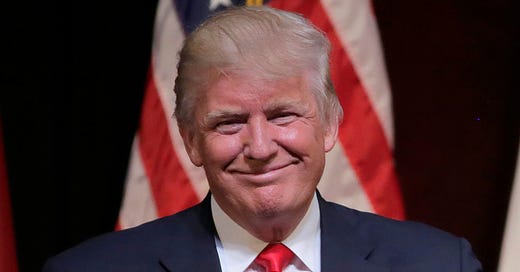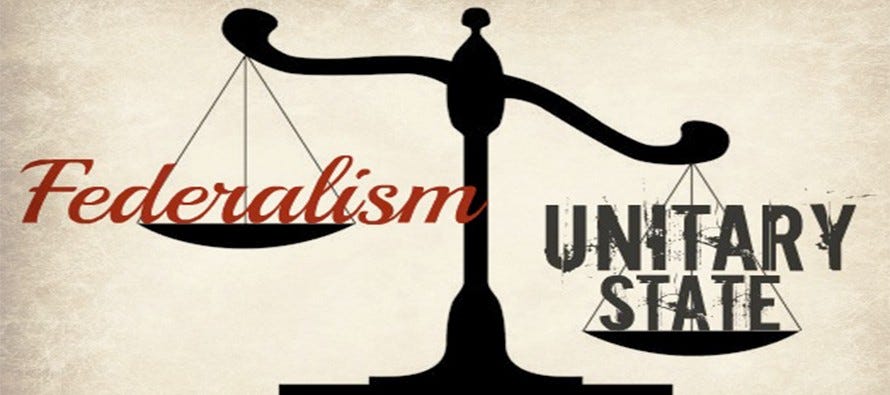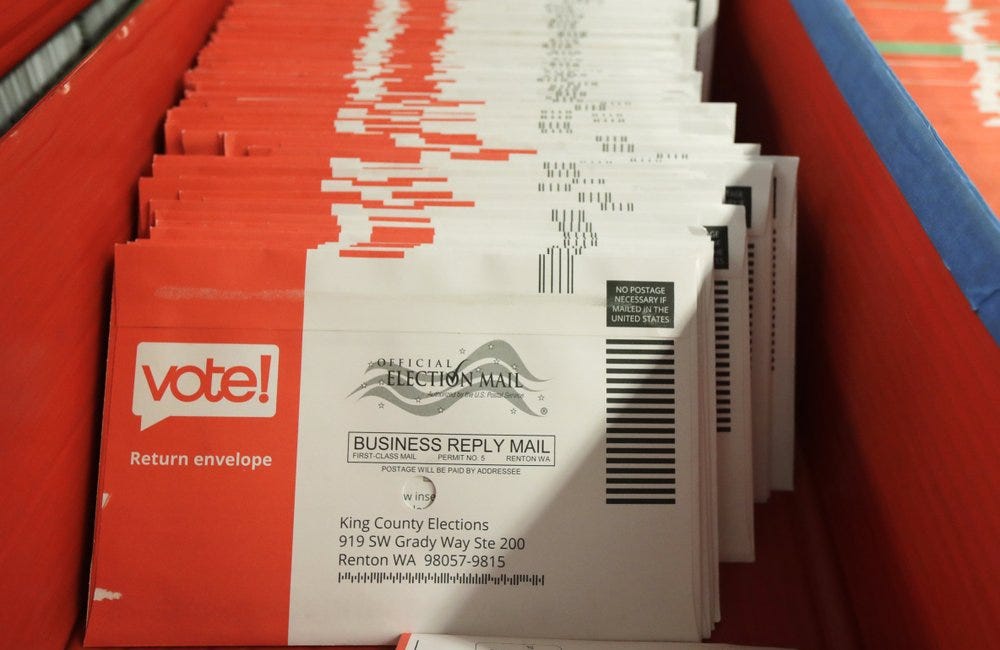Priorities for the second Trump administration
Now comes the hard part for Trump and the Republicans…
Make someone’s day: Gift a subscription to your friends and family!
This article is first in an extended series of articles giving policy reform advice to the Trump administration from the Progress-based perspective. After finishing this article, I would suggest reading the rest of the series from the “Table of Contents”.
Now that the 2024 election has settled a little bit in people’s minds, I wanted to write an article outlining what I think the priority of the second Trump administration should be. For the record, I am not surprised at all by the results and have been expecting a big Republican win since it became obvious that Donald Trump would be the Republican nominee for President.
What I write below is not:
a prediction of what will happen.
what I would do if I were elected President with governing majorities in Congress (I sketched out my preferred policy yesterday along with many other policy reform proposals in other articles)
This article is a blend of the following:
What I believe (I am not going to favor a policy that I disagree with)
What research in Progress Studies shows is good for promoting long-term economic growth
What Donald Trump says he believes
Focusing on the issues that Trump appears to deem important enough to act on. The vast majority of what Presidential candidates say on the campaign trail never gets implemented, so issue prioritization is at least as important as issue stands.
For the purposes of this post, I really do not care whether you like Donald Trump or voted for him, so please keep your comments to the actual topic of the post.
Federalism: one simple reform to solve all our problems
Make someone’s day: Gift a subscription to your friends and family!
See my other articles about policy reform proposals:
A simple and cost-effective plan to quickly lower US carbon emissions
Medical treatment should have transparent prices and open competition
If you are interested in this topic, you should read my “From Poverty to Progress” book series:
I used to be a professor of Political Science and Public Policy who specialized in campaigns and elections and a former state-level candidate, so I always find legislative strategy to be an interesting thought experiment. I often like to strategize about what I would do if I were a national leader in a given circumstance. This helps to hone down your beliefs to what is actually achievable while prioritizing what is most consequential. Regardless of what you think of Donald Trump and the Republican party, it is still fun to strategize.
The outcome of the 2024 election was impressive for Donald Trump and the Republicans, but what comes in 2025 is far more important. Either Trump and a Republican party take advantage of the opportunity or they fail to do so (similar to Obama in 2009. Based on what I am seeing from Republicans, they seem to think that they have achieved something important.
No, the 2024 election result just gives the Republicans the opportunity to achieve something. And time is very short, far shorter than most Republicans realize.
Constraints on implementing Presidential policies
First, a few observations from Political Science about how American Presidents get things done. All of these put serious constraints on Trump’s agenda. If you do not care about these constraints and want to get right to my proposed agenda, you can skip to the next section:
A new President usually only has about 15 months to implement his legislative agenda. After that Congress is already thinking about midterm elections in 2026, and after that comes the “lame duck” period when Presidents have great difficulty getting legislation through Congress.
Given that this is Trump’s second term, he will likely not be able to accomplish much after April 2026 in passing Congressional legislation. This will give him an incentive to focus on foreign relations in the second half of his term.
This is a huge constraint as there is only so much that can be done in only 15 months.Midterm elections like what is coming in 2026 almost always swing towards the party that does not hold the Presidency. Currently, Republican margins in the US House are just not large enough to survive a typical midterm election. The Democrats will likely retake the US House in 2027.
This means that even if everything goes well for Trump, the Democratic party will likely have veto power over all Congressional legislation in January 2027. The Democrats can just stall until the 2028 election, and there is little Republicans can do.Election outcomes are heavily dependent on the state of the economy. Contrary to what even expert pundits think, the President has very little control over the national economy. The American economy is really the outcome of 330 million Americans making decisions along with shocks coming from overseas. No one is in charge of the American economy.
As unfair as it sounds, even though the President has relatively little control over the economy, the American people still hold the president accountable for the economy. Along with a Presidential scandal and an unpopular war, an economic recession is the primary reason why Presidents lose elections.Related to the above, a recession is guaranteed to come in the future. It may be in 2025, 2026, 2027, 2028, or a few years later. No one knows when it will come, but it will happen for sure. That is just how the economic cycle works.
An economic recession in 2025 would destroy the Trump II Presidency regardless of what he does in office, and a recession in 2027-28 would destroy Republican chances in the 2028 Presidential election. Once an economic recession starts to bite, the vast majority of swing voters who swung to the Republicans in 2024 will swing back the other way.Congress as an institution is far more powerful than the President in domestic issues, but since Congressional power is divided between 535 elected officials, it does not seem that way. People assume that the President is far more powerful than he actually is.
The President is very influential in foreign and military policy, but far less so in domestic issues. In domestic issues, Congress is in the driver’s seat, not the President.
The President can propose legislation and veto legislation, but it is Congress that writes the legislation and passes it. Congress presents the President with legislation that he can either sign as is or veto.
The partisan composition of Congress is critical to Presidential success.
Since the US House is driven by party discipline, it really matters whether the President has the majority in the House. It matters much less how big that majority is, only that the President has a majority. In other words, it is a binary Enough Support vs. Not Enough Support.
Since the US Senate is much more personalistic (like herding cats), being the majority party is less important, but the number of supportive Senators (from either party) is key. Ideally, a president needs 60 loyal Senators for either party to invoke cloture on filibusters, but that is very difficult to achieve.
More achievable is a 53-47 majority of supporters or more for any key bill, so none of the “cats” have the incentive to chase after squirrels. Such a working majority is also key to the Senate approving Presidential appointments to the federal bureaucracy and courts.Based on election results as of today, Trump has both, but just barely. This gives him some flexibility, but getting his preferred legislation through Congress is far from a slam dunk. Senators, in particular, hate being told what to do by a mere President.
The primary Presidential power in domestic policy-making is to set the legislative agenda. There are always hundreds of different issues that the federal government can focus on, but only a few of them can be dealt with at any one time. The President has real influence in determining which of those issues are on the current legislative agenda, particularly in his first year in office.
The President is particularly helpless in the federal budget process, which is probably the most important power in the federal government. Congress decides how much to spend on each budgetary item. Presidential budget proposals submitted in early February (just weeks after inauguration) are almost always ignored. Power over the budgetary process is deliberately decentralized across many different Congressional committees.
The following Congressional committees rule the annual budget process for discretionary spending with an iron fist:House and Senate Budget Committees set overall “302(a)” spending limits in a budget resolution, which must be approved by both the House and the Senate.
House and Senate Appropriations Committees set more granular 302(b) spending levels for each of the 12 appropriation bills. The total spending must add up to the limit set by the prior budget resolution.
House and Senate Appropriations sub-committees determine spending for individual programs within the 302(b) limits set by the full Appropriations committees. This detailed budget must then be approved by:
Both of the full House and Senate Appropriation Committees, and
Both the House and the Senate (Phew! Sorry for the digression, but the budget process is complicated, and it seriously constrains Presidential power).
The President has unitary power over the federal bureaucracy.
Given how important overhauling the federal bureaucracy is to Donald Trump, he will likely try to use executive orders to fundamentally reshape the federal bureaucracy. It is unclear whether the Congress or Supreme Court can stop him from doing so.Presidential priorities are often diverted by wars, scandals, natural disasters, and whatever “the current issue” is. The media can play a big role in distracting Presidential focus and given how hostile they are to the current President, they have a strong incentive to do so. Even distracting Trump for one month could be enough to seriously undermine his legislative accomplishments. He must focus with laser-like intensity.
Putting this all together, to be successful, President Trump must focus relentlessly on 3-4 bills that he can submit to Congress and spend a great deal of time campaigning in their favor. He can lobby Congress directly or indirectly via the American people.
In addition, the President can also pass some executive orders that do not require Congressional approval. The President also needs to spend a significant amount of time on:bureaucratic appointments.
judicial appointments
foreign policy
Given the Democratic and media hatred of Donald Trump, they will have a huge incentive to manufacture scandals that divert executive attention during the first 15 months in office. And given social media, this could be as mundane as a mean Tweet on X or Truth Social.
The proposed Trump agenda for 2025
Enough already, let’s get to the point.
What should Trump do?
The shortlist is:
A massive roll-back in the growth of Soft Totalitarianism, particularly censorship, DEI, and the voting process.
Promote long-term economic growth. Without long-term economic growth, little else really matters.
More specifically, here is my prioritized list for the Trump administration.
End social media censorship by the federal government. Eliminate every federal department where there is credible evidence that has participated in this practice.
Ideally, follow this up with Congressional legislation or an executive order requiring social media companies to abide by First Amendment standards to be protected legally by Section 230 of the Communications Act, but this may be overstretch.
The First Amendment has stood the test of time for 250 years so it can be made to be flexible enough to apply to social media companies.Massive rollback of DEI policies in the federal government, federal contractors, and recipients of federal government funding (via executive order).
Eliminate every federal department and job position that has any of the words “Diversity,” “Equity,” or “Inclusion” in their title at any time during 2020-2024 and fire all the employees permanently.
Declare that all DEI practices are a violation of the Civil Rights Act of 1964 (which it clearly is).
Rescind every executive order that was the foundation for affirmative action and DEI.
Ban DEI training or any training that differentiates by race or gender anywhere in the federal government.
Ban hiring, firing, and promotions using any racial or gender criteria.
Ban manager incentives to hire, fire, or promotion for diversity within the federal government.
Require federal contractors to do all the above to keep their contracts going or receive new federal contracts.
Ban federal funding going to any private or non-profit institution that has the above DEI practices.
Use the power of the Department of Justice to sue large corporations that have implemented DEI-based hiring, firing, promotion, and training policies because those practices violate the Civil Rights Act of 1964, but give corporations one year to roll back the policies.
Promise a wave of DOJ lawsuits against corporations that do not rescind all those DEI policies by the end of 2025. Otherwise, the lawsuits start in January 2026.
You can read more about my proposal here:Trump needs to completely roll back DEI
·Make someone’s day: Gift a subscription to your friends and family!
Pass Congressional legislation to dramatically increase ballot security in federal elections by requiring photo identification and ending mail-in ballots and ballot harvesting. You can read more about my proposal in this article:
We should overhaul the federal voting process
·Make someone’s day: Gift a subscription to your friends and family!
Unleash the power of Shale oil and gas and eliminate federal subsidies and mandates for Green energy. This will likely lead to a sharp drop in energy prices, which can help drive manufacturing and a higher standard of living.
I have written many articles on the subject, so I will not go into too much detail here.Eliminate Biden EPA regulations designed to close natural gas plants.
Approve virtually all exploration, drilling, and distribution of oil and gas on federal lands.
Radically cut regulations that delay or stop energy infrastructure construction (renewable and otherwise). Focus on oil and gas pipelines that connect the shale fields to existing pipelines.
Eliminate all federal subsidies and mandates for Green energy (and all other energy sources). You can read more about this proposal here:
Trump should eliminate Green energy subsidies and mandates
·Make someone’s day: Gift a subscription to your friends and family!
Overhaul nuclear regulation so that it can become cost-effective again. Work with South Korea (the masters of low-cost nuclear) to approve a single cost-effective design that can be replicated across the nation.
Establish an innovation prize for future energy breakthroughs.
Overhaul immigration policy and enforcement:
A complete overhaul of American immigration policy that exclusively allows in highly-skilled workers who can make the greatest contributions to the nation. This means eliminating virtually all other types of legal immigration.
Strict enforcement against illegal immigrants both at the border and internally.
You can read more about this proposal here:America needs a skills-based immigration policy
·American immigration policy is broken, and it has been broken for 60 years. And few politicians in either party propose a better system. Typically, politicians, pundits, and activists focus on how much immigration we should allow (legal and illegal), but very few of them focus on the far more important issue of
Radically reduce federal regulations, particularly those related to energy, transportation, manufacturing, and housing.
Require the secretaries of Energy, Interior, Transportation, and HUD to create a list of vital construction projects that the President can fast-track past regulatory review.
Aim for a 50% or greater reduction in federal regulations by the end of 2028. You might think that this is an unrealistic goal, but the state of Idaho almost doubled this goal in less time (an estimated 75% cut or simplification in one year)
Require all Cabinet appointees and their subordinates to file weekly reports showing their progress toward that goal.
For every new regulation implemented, they must eliminate three additional regulations over and above the 50% rule.
You can read more about my proposal here:We need massive deregulation now
·Make someone’s day: Gift a subscription to your friends and family!
Cut corporate income tax rates to 10% and eliminate virtually all tax exemptions. Eliminate all income taxes for corporations that:
have all their employees (except overseas marketing and sales employees) within the United States, and
all their sub-contractors have the same.
I know that Trump did not campaign on this issue, but I think that it is a much more viable and cost-effective alternative to his tax and tariff policies (which I disagree with).
Priorities #1, 2, and 6 can likely be accomplished via Presidential executive orders, while priorities #4, 5, and 7 will require Congressional legislation. That means that only four major pieces of legislation will be needed. If Trump focuses relentlessly on these issues, it is achievable within 15 months.
Goals #1, 2, and 3 are to stop the trend towards Soft Totalitarianism.
If aggressively and comprehensively done, I think that we can kill this trend in 2025, and make it much easier for other nations to do the same. Ignoring this trend will endanger everything else as the federal bureaucracy will just undo every Trump achievement at a later date.
Goals #4, 5, 6, and 7 are to unleash economic growth.
No matter how successful the Trump administration is at passing “anti-Woke” policies, if the economy is not growing, nothing else will matter. The combination of cheap abundant energy, lower regulations, lower corporate taxes, and an economic incentive to onshore manufacturing will likely kick massive economic growth, particularly in energy, housing, and manufacturing. This will matter far more to most voters than any other issue.
Other issues
Note that I would love to make housing a much bigger priority on this list because affordable housing is critical, but I think deregulation is probably about the biggest impact that a President can have on this issue. Housing is largely a state and local issue, and the federal government does not have much influence. Republican governors and state legislatures in Red states will need to take the lead on this issue.
By the way, I love the Freedom Cities Initiative (actually proposed by me in my second book before Trump went public), but this will take too much time to implement. It will take years just to design the cities and start construction, so it unfortunately needs to wait. This policy initiative will likely have to wait for future presidents.
Maybe use the DOJ to convince the Supreme Court to revisit the Village of Euclid v. Ambler Realty Co. case to rule against the constitutionality of zoning rule? This is a low odds of success, but potentially a huge win.
Here are more details on my “Homestead 2.0” housing policy proposal:
Did Donald Trump steal my "Freedom City" idea?
Make someone’s day: Gift a subscription to your friends and family!
What Trump should not do
This is actually more important than the list above.
I know that it will be difficult for anyone to change Donald Trump’s mind when he really wants something, but I think his advisors should sternly tell him not to divert his attention to lesser issues.
The key message to President Trump should be aggressive and effective action on the issues that matter most. It is better to leave a real legacy on a few important issues rather than little to nothing on many issues.
Here is a list of issues that it would be unwise to focus on:
High-profile investigations of wrongdoing by federal bureaucrats and Democrats. This is going to be hard to avoid as they deserve prison time if there is clear evidence that they broke the law. In addition, his MAGA supporters will be screaming for blood. Given that the Democrats have used “lawfare” against Trump and their supporters, it will be very easy to argue that “turn about is fair play.”
But putting a few bad eggs in prison will have zero impact on the federal government going forward. The next bureaucrat will just step into their place. In a previous article, I outlined a plan far more radical and effective plan than imprisoning a few bureaucrats and politicians.Tariffs other than those carefully targeted on key Chinese industries that threaten American national security or enable China to create high-tech industries and military production.
My alternative proposal #6 will likely be as effective as tariffs and much less costly and politically controversial. And it will not risk triggering a trade war with our allies. Tariffs are a 2000-pound bomb with much collateral damage. Choose a sniper rifle as a weapon instead.
Don’t get me wrong. The threat of imposing tariffs against a specific nation can be a powerful weapon to get concessions from foreign nations, such as:Cooperation with Mexico and other nations on border control.
Increased military spending from NATO Europe.
A sweeping tax reform that reduces individual income tax rates, other than those listed above. This was the mistake made by GW Bush and Trump I.
Big tax cuts sound good to loyal Republicans, but getting it through Congress will use up all the legislative bandwidth and make the federal debt much bigger.
My proposed goals #4, 5, 6, and 7 will have a bigger positive impact on economic growth.Focus all immigration attention on cutting overall levels of immigration and deporting illegals within the first 15 months. This will backfire, and the media or social media is guaranteed to find a tragic video that leads to a “George Floyd” movement that could potentially undermine the entire Trump agenda.
By shifting to encouraging highly-skilled immigrants (which Trump has favored in the past), this is good for the economy and far more politically popular.
Properly done, Trump can set the standard for immigration policy for the next few generations, but if this is poorly done, he could bring down his entire administration.Foreign policy.
This can wait until after April 2026. Do not waste valuable time focusing on issues other than getting Congressional legislation passed in the first 15 months. Due to a foreign crisis, this may not be possible, but it should at least be the goal.Reforming Social Security, Medicare, Medicaid or CHIP
This is going to have to be done within a decade, but trying to do so within the first 15 months would be political suicide. Most likely, this will have to wait until after 2028.
My Commenting rules
The vast majority of my posts are open to comment by all. Within the constraints of my writing schedule, I enjoy having conversations with people with differing opinions as long as commenters follow these rules:
Read the entire post first.
Given that my opinions are unorthodox, do not assume that you understand my point of view from the headlines or skimming the article.Stay on topic.
Be respectful and open to learning. I will do the same.
Anyone who violates the above rules may be blocked or have their comments deleted. I really do not care whether you like Donald Trump or voted for him, so please stick to the topic of the post.
See my other articles about policy reform proposals:
A simple and cost-effective plan to quickly lower US carbon emissions
Medical treatment should have transparent prices and open competition
If you are interested in this topic, you should read my “From Poverty to Progress” book series:













That was really interesting and informative, and written in a style that encourages reading to the very last word.
Thank you, I shall keep an eye out for your work in the future.
I think you meant April 2026 twice in the article when you referred to the end of the first 15 months.